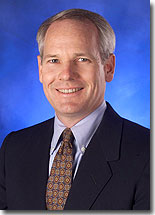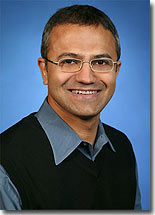REDMOND, Wash. – Dec. 8, 2011 – Last night, Kurt DelBene, president of the Microsoft Office Division, and Satya Nadella, president of Microsoft’s Server and Tools Business, had dinner with a group of journalists in San Francisco to talk about their businesses and cloud computing. Microsoft News Center had a chance to sit down and talk with them and hear what’s new, what’s unchanged, and what their businesses have in common.
Microsoft News Center: The cloud has been a hot topic in the tech industry for quite some time. As businesses start to transition some of their IT to the cloud, can you break it down for us? What is really going to change for IT and businesses?

Kurt DelBene, president of the Microsoft Office Division.
Kurt DelBene: In our view, the cloud presents a substantial set of opportunities, choices and cost-savings scenarios for businesses looking to improve their capabilities and productivity. What I typically hear from customers is that their IT departments are not making cut-and-dried decisions to “move to the cloud,” but rather they look at their aging infrastructure and know they need to upgrade. They need to implement a new set of tools and capabilities to keep up with and serve their users, and the best path for this upgrade is unique to each customer. This is where the power of cloud computing comes into play. It can provide flexibility and choice to IT organizations. They can put certain capabilities into the cloud and re-purpose resources while improving reach and flexibility for their users. In addition, the cloud has opened doors for businesses to access specific technologies that make them more productive. For example, many customers in the small and medium-size business space don’t have the IT capabilities to deploy an Exchange Server or a SharePoint Server, and now they can have those same capabilities through the cloud.
Satya Nadella: I agree — and to break it down a bit further, one consistent change we’ve identified is in the world of devices. In the infrastructure business, we first try to recognize any architectural pattern shifts in application development and deployment to determine where the industry is headed. And when we talk to customers about the types of applications they’re now building, we find they’re broadly classified as device and cloud applications. In that context, we’re seeing enterprises in particular, looking at the cloud as a way to reach the multitude of devices. For example, easyJet, a budget airline that is conscious of cost, needed to reach its terminals in a new way. It implemented a cloud-based service using Windows Azure and yet was able to keep its data inside its enterprise. It is a great example of a company that has taken its existing internal infrastructure, and extended it to reach new devices, empowered by the cloud.
Microsoft News Center: What do you think are the biggest myths out there about the cloud?
Kurt DelBene: I think that one of the bigger myths about cloud computing is around business needs and their complexity. It’s not as if the cloud suddenly means that a company can re-purpose a consumer-class product to fit all its needs simply because people use it outside work. Businesses still have to meet compliance needs, and they need to access their historical records, among other things. These requirements existed before, and they didn’t go away because of a cloud transition. The cloud can increase access and boost productivity, but traditional business needs are still very complex.
Satya Nadella: On my end, I think it’s becoming much clearer that IT will actually drive the transition to the cloud, and not be replaced by it. As our customers and partners embrace this, we’re seeing a lot of creativity and energy that is really going to drive the next generation of computing.
Microsoft News Center: Given that businesses are gradually making this change then, what’s unique about Microsoft’s approach to the cloud for business customers?

Satya Nadella, president of the Servers and Tools Business at Microsoft.
Satya Nadella: First and foremost, we believe we have the broadest set of cloud technologies and offerings across the industry, which means that our customers can make the move to the cloud on their terms, and have the ability to pick and choose the tools and capabilities they need for their business.
Kurt DelBene: I agree — it is about Microsoft’s breadth of offerings, our critical business features, and our hybrid approach that allows customers to embrace the cloud on their terms. In the Office Division, we know how people operate at work and at home based on millions of users and years of experience. We use that knowledge to determine how moving to the cloud can help our customers solve the problems they have today, such as access to their business email from anywhere, and help them transition their businesses and their productivity experiences.
Satya Nadella: And then I think it’s also about the business relationship our customers have with Microsoft as well. We enable business arrangements that allow existing customers to start using our cloud offerings under the enterprise agreements they have today. So as we move to the cloud we are working both as trusted advisors on the technology and trusted business partners to our customers.
Microsoft News Center: Given the breadth of offerings across the company, how are your customers choosing which services to implement? What guidance do you provide to make sure they’re choosing the right technologies for their needs?
Kurt DelBene: Most of our customers’ interest in the cloud is really a timeline associated with their urgency to address their underlying goals. We hear the set of capabilities that they are looking for are the same or better capabilities than they often have today, including technologies such as Lync, Exchange and SharePoint. So we’re really helping our customers implement the next generation of their infrastructure, based on the enterprise requirements they have. Our customers just want to have the assurance that we can provide the same noncompromised versions of solutions to them, and deliver on their business needs.
Satya Nadella: Taking a deeper look at the platform, for us it’s really become about enabling hybrid cloud scenarios for most of our customers. The notion that “everything is moving to the public cloud” isn’t entirely true, but so is the notion that “everything is just going to stay nonvirtualized.” When you think about the IT backbone that you build as a CIO or the application portfolio that you have as an enterprise, you’re really going to have to look at using a mix of cloud and on-premises technologies to run your business. The bottom line is that we’re the only cloud provider with this breadth of offerings, joined by common development tools and directory services, giving us the ability to help customers with hybrid cloud solutions, which is clearly where the most value lies for businesses.
Microsoft News Center: Both of you are relatively new to your roles as presidents. How is it different from your previous roles at Microsoft? Why are you so passionate about the cloud?
Kurt DelBene: I’d like to say it’s just like my former role (senior vice president, Office Business Division), but the truth is that there is a lot to running a business that isn’t part of running a broad development organization. (Laughs) For instance, I’m still getting used to speaking in front of thousands of people and the extensive travel to different regions all over the globe. What really drives me to come into work every day though is that I get to meet with and hear from a lot of our customers. I love having that insider view, because they equip us with what we need to continually grow and become a better company. Microsoft will be one of the biggest cloud providers in the world. In my job, I am able to help shape that future and change the way people work on a global scale that few others can imagine. It’s a fantastic opportunity.
Satya Nadella: For me, this job is fast, it’s energetic — we’re at a point now where we are doing much more anticipating, looking at cross-cutting scenarios, and the cumulative effect across our businesses is much bigger than any one piece. This role allows me to leverage my experience working on the largest Web services and cloud infrastructure on the planet, serving hundreds of millions of customers each day around the world, and find innovative new ways to help businesses use their IT infrastructure to reach their full potential. We – Microsoft and its customers – are all on this road together, and can’t wait to see how much more we learn and discover over the next couple of years — it’s just a really exciting time in the industry right now and I’m happy to be a part of it.




